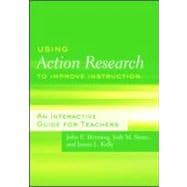
Note: Supplemental materials are not guaranteed with Rental or Used book purchases.
Purchase Benefits
Looking to rent a book? Rent Using Action Research to Improve Instruction: An Interactive Guide for Teachers [ISBN: 9780415991742] for the semester, quarter, and short term or search our site for other textbooks by Henning; John E.. Renting a textbook can save you up to 90% from the cost of buying.
| List of figures | p. ix |
| List of tables | p. xi |
| Preface | p. xiii |
| Acknowledgements | p. xvii |
| Introduction | p. 1 |
| An Introduction to Action Research | p. 3 |
| What is Educational Research? | p. 3 |
| What is Action Research? | p. 5 |
| Creating a Research Persona | p. 7 |
| Plan, Collect Data, Analyze, and Reflect | p. 8 |
| Research Ethics | p. 10 |
| Summary | p. 14 |
| Planning an Action Research Project | p. 15 |
| Introduction | p. 15 |
| Formulating a Research Question | p. 15 |
| Searching for a Strategy | p. 19 |
| Searching the Educational Literature | p. 22 |
| Selecting the Methods | p. 29 |
| Summary | p. 34 |
| Making Observations | p. 35 |
| Observing Students and Their Work | p. 37 |
| Introduction | p. 37 |
| Making Careful Observations | p. 38 |
| Steps in Observational Research | p. 40 |
| Observing Students | p. 41 |
| Using Checklists | p. 49 |
| Analyzing Student Work | p. 50 |
| Analyzing Student Talk | p. 53 |
| Summary | p. 61 |
| Observing Teachers | p. 62 |
| Introduction | p. 62 |
| Steps in Observing Teachers | p. 63 |
| Open-Ended Observations | p. 63 |
| Using Checklists | p. 64 |
| Analyzing Audiotapes, Videotapes, or Verbatim Transcripts | p. 70 |
| Summary | p. 76 |
| Gathering Perceptions | p. 77 |
| Using Surveys in Action Research | p. 79 |
| Introduction | p. 79 |
| Steps in Survey Research | p. 80 |
| Plan | p. 80 |
| Collect Data | p. 88 |
| Analyze | p. 88 |
| Reflect | p. 92 |
| Summary | p. 93 |
| Using Interviews in Action Research | p. 94 |
| Introduction | p. 94 |
| Steps in Conducting an Interview | p. 95 |
| Types of Interviews | p. 95 |
| Determining Your Research Question | p. 96 |
| Selecting Participants | p. 97 |
| Writing Interview Questions | p. 98 |
| Preparation for the Interview | p. 101 |
| Conducting the Interview | p. 102 |
| Analyzing the Interview Data | p. 102 |
| Summary | p. 106 |
| Analyzing Test Results | p. 109 |
| Standardized Test Analysis | p. 111 |
| Introduction | p. 111 |
| Steps in Analyzing Standardized Tests | p. 112 |
| Comparing to the Norm (by Individual) | p. 113 |
| Comparing to the Norm (by Class, Grade Level, Building, or District) | p. 115 |
| Disaggregating Data | p. 117 |
| Analyzing Trends | p. 120 |
| Mixed Analysis | p. 123 |
| Correlating Data | p. 124 |
| Summary | p. 126 |
| Pre- and Post-Tests | p. 128 |
| Introduction | p. 128 |
| Steps in Comparing Pre- and Post-Tests | p. 129 |
| Comparing Pre- and Post-Tests | p. 129 |
| Comparing Subgroups | p. 131 |
| Individual Adaptations | p. 132 |
| Evaluating Teaching Strategies | p. 133 |
| Developing New Teaching Strategies | p. 134 |
| Deciding on a Research Question | p. 135 |
| Summary | p. 135 |
| Talking and Writing about Action Research | p. 137 |
| Collaborating on Action Research | p. 139 |
| Introduction | p. 139 |
| Establishing Group Norms | p. 140 |
| Managing Time | p. 141 |
| Choosing Your Data | p. 141 |
| Structuring the Discussion | p. 142 |
| Summary | p. 147 |
| Reading and Writing Action Research | p. 149 |
| Introduction | p. 149 |
| Plan: Purpose Section | p. 151 |
| Plan: Participants and Setting | p. 151 |
| Plan: Source of Data | p. 152 |
| Data Collection | p. 153 |
| Findings | p. 154 |
| Reflection | p. 156 |
| Summary | p. 157 |
| Action Research Report Example | p. 159 |
| Sample Answers and Discussion Guide | p. 170 |
| Further Reading | p. 200 |
| References | p. 201 |
| Index | p. 203 |
| Table of Contents provided by Ingram. All Rights Reserved. |
The New copy of this book will include any supplemental materials advertised. Please check the title of the book to determine if it should include any access cards, study guides, lab manuals, CDs, etc.
The Used, Rental and eBook copies of this book are not guaranteed to include any supplemental materials. Typically, only the book itself is included. This is true even if the title states it includes any access cards, study guides, lab manuals, CDs, etc.